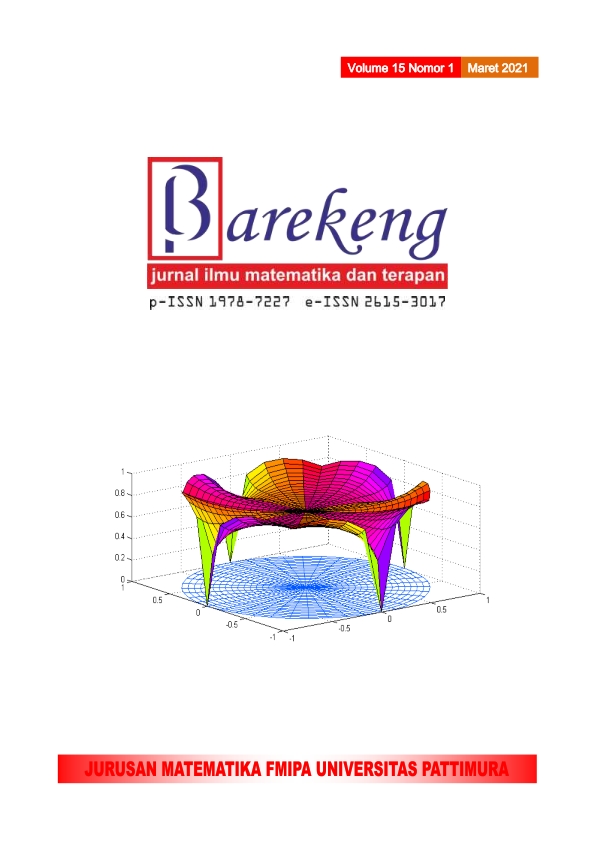CORRESPONDENCE ANALYSIS PADA HUBUNGAN FAKTOR-FAKTOR YANG MEMPENGARUHI PENDAPATAN PETANI KOPI PAGARALAM
Abstract
Pagaralam is one of the coffee-producing districts in South Sumatra (Sum-Sel). Pagaralam coffee farming is a hereditary business, where the majority of land processing is still traditional. This is related to working capital and farmers' income. This study aims to analyze the factors that affect the income of Pagaralam coffee farmers by using correspondence analysis. There are 30 variables or factors studied. Each variable is divided into several categories. The categories of each variable are described graphically with the categories of income variable. Primary data were obtained from 196 respondents who were selected based on purposive sampling technique. There are 13 factors that affect the income of respondents, namely: number of dependents, number of trees, age of the trees, number of female workers from outside the family, frequency of fertilization, frequency of herbicide application, production of harvest, production outside of harvest, gross income, minimum price of coffee beans, the maximum price of coffee beans, economic status and land productivity. There are 8 of the 13 factors that predominantly characterize the profile of net income level of Pagaralam coffee farmers. In general, the factor that must be considered in coffee farming is land productivity which is also related to production costs in land processing and crop production, as well as external factors regarding the market price of coffee.
Downloads
References
Ditjenbun, “Peluang ekspor perkebunan masih bertahan,†21 Desember 2020, [Online]. Tersedia: http://ditjenbun.pertanian.go.id/2020/ [Diakses: 1 Februari 2021]
P. Baker, “Global Coffee Production and Land Use Change,†2014, [Online]. Tersedia: https://www.researchgate.net/publication/273445289_Global_Coffee_Production_and_Land_Use_Change [Diakses: 30 Agustus 2020]
SCP (Sustainable Coffee Program), “A business case for sustainable coffee production,†March, 2014, [Online]. Tersedia: http://exchange.growasia.org/indonesia-business-case-sustainable-coffee-production [Diakses: 17 Maret 2019]
Ditjenbun, “ Statistik Perkebunan Indonesia, Komoditas Kopi 2015-2017 (Statistics of coffee plantation in Indonesia 2015-2017),†2018. Jakarta: Kementerian Pertanian Republik Indonesia.
K. Sarirahayu and A. Aprianingsih, “Strategy to Improving Smallholder Coffee Farmers Productivity Literature Study,†vol. 11, no. 1, pp. 1–9, 2018.
Irmeilyana, Ngudiantoro, A. Desiani, and D. Rodiah, “Deskripsi hubungan luas areal dan produksi perkebunan kopi di Provinsi Sumatra Selatan,†in Proseding SEMIRATA BKS PTN Indonesia Barat, pp. 74–86, July 6-7, 2019.
Irmeilyana, Ngudiantoro, A. Desiani, and D. Rodiah, “Deskripsi hubungan luas areal dan produksi perkebunan kopi di Indonesia menggunakan analisis bivariat dan analisis klaster,†Infomedia, vol. 4, no. 1, pp. 21–27, 2019, doi: http://dx.doi.org/10.30811/jim.v4i2.1534.
R. Hulupi and E. Martini, Pedoman Budi Daya dan Pemeliharaan Tanaman Kopi di Kebun Campur. Bogor: World Agroforestry Centre (ICRF) Southeast Asia Regional Program, 2013.
J. R. Saragih, “Kinerja Produksi Kopi Arabika dan Prakiraan Sumbangannya dalam Pendapatan Wilayah Kabupaten Simalungun,†VISI, vol. 18, no. 1, pp. 98–112, 2010.
Z. Fatma, “Analisis fungsi produksi dan efisiensi usahatani kopi rakyat di Aceh Tengah,†Thesis, IPB, Bogor, 2011.
A. Rofi, “Strategi peningkatan pendapatan petani kopi di Desa Boafeo Kecamatan Maukaro Kabupaten Ende NTT,†Majalah Geografi Indonesia, vol. 32, no. 1, pp. 77–83, 2018.
S. A. Sembiring, J. Hutauruk, P. Nababan, S. Ginting, and D. C. Barus, “The measurement of cash flow on arabica coffee farmers,†in IOP Conf. Series: Earth and Environmental Science, 2018.
K. Isaac and S. Gwali, “Productivity and profitability of robusta coffee agroforestry systems in Central Uganda,†Uganda J. Agric. Sci., vol. 13, no. 1, pp. 85–93, 2012, [Online]. Tersedia: https://www.researchgate.net/publication/236901244.
S. Thamrin, “Faktor-faktor yang mempengaruhi produksi usahatani kopi arabika di Kabupaten Enrekang Sulawesi Selatan,†AGRIC, vol. 26, no. 1–2, pp. 1–6, 2014.
B. Ginting, H. L. Nainggolan, and G. B. Siahaan, “Analisis faktor-faktor yang mempengaruhi sentra produksi komoditi kopi di Kabupaten Humbang Hasundutan,†Agrisep, pp. 69-79, 2018.
S. M. Silitonga, Salmiah, and L. Sihombing, “Analisis komparasi tingkat pendapatan usahatani kopi dengan berbagai pola tanam (monokultur dan polikultur) di Kabupaten Dairi Kecamatan Sumbul Desa Tanjung Beringin,†J. Soc. Econ. Agric. Agribusiness, vol. 2, no. 3, pp. 1–15, 2013.
Nurhapsa, A. Nuddin, Suherman, S. N. Sirajuddin, A. M. Al-Tawaha, and A. R. M. Al-Tawaha, “Factors affecting coffee use income: a case study in the province of South Sulawesi, Indonesia,†Ecol. Environ. Conserv., vol. 26, no. Feb Suppl. Issue, no. 265-273, pp. 265–272, 2020, [Online]. Tersedia: http://www.envirobiotechjournals.com/article_abstract.php?aid=10255&iid=296&jid=3.
Irmeilyana, Ngudiantoro and A. Desiani, “Analisis perbandingan profil pengrajin di tiga sentra kerajinan tenun songket Palembang,†Infomedia, vol. 3, no. 2, pp. 58–63, 2018, doi: 10.30811/jim.v3i2.714.
Irmeilyana, Ngudiantoro, and D. Rodiah, “Deskripsi profil dan karakter usaha tani kopi Pagar Alam berdasarkan descriptive statistics dan korelasi,†Infomedia, vol. 4, no. 2, pp. 60–68, 2019, doi: http://dx.doi.org/10.30811/jim.v4i2.1534.
R. A. Johnson and D. W. Wichern, Applied Multivariate Statistical Analysis, 6th ed. New Jersey: Prentice-Hall, Inc., 2007.
Authors who publish with this Journal agree to the following terms:
- Author retain copyright and grant the journal right of first publication with the work simultaneously licensed under a creative commons attribution license that allow others to share the work within an acknowledgement of the work’s authorship and initial publication of this journal.
- Authors are able to enter into separate, additional contractual arrangement for the non-exclusive distribution of the journal’s published version of the work (e.g. acknowledgement of its initial publication in this journal).
- Authors are permitted and encouraged to post their work online (e.g. in institutional repositories or on their websites) prior to and during the submission process, as it can lead to productive exchanges, as well as earlier and greater citation of published works.






1.gif)



